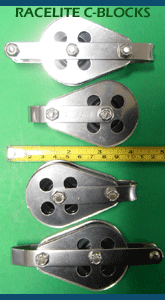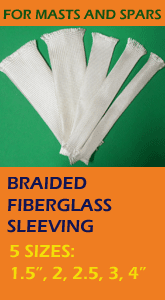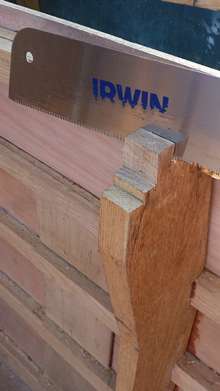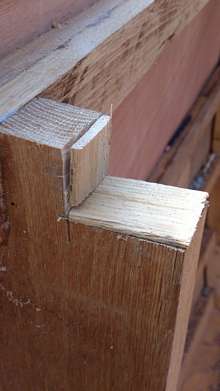|
Boat building disasters can happen so easily - and do. More so to some people than others it must be said, particularly the novice builder. So I thought it would be a good idea to share my experience and offer some words of encouragement and sage advice on managing the situation for the amateur boat builder.
All of us have disasters, after all we are only human, but it is how you handle the situation afterwards that counts, particularly your frame of mind and how quickly you recover the situation. Disasters are very subjective, being totally dependent on how you view them. What for one person may be a minor annoyance, could reduce another person to tears of frustration and broken tools thrown down in rage. Generally the more experienced builders will have seen the same disasters before and so will have built up immunity to them.
In order to discuss and compare disasters in a rational manner, we first need to be able to quantify the damage. Fortunately we can easily do this due to the work of Francis Bowfort who devised the following scale of disaster measurement (not Admiral Sir Francis Beaufort the man who proposed the wind measurement scale we all use).
Category |
Description |
Action |
1 |
Hardly noticeable |
Carry on regardless |
2 |
Just noticed |
Frown or grimace required |
3 |
Minor annoyance |
Pause for thought |
4 |
Major sigh |
Make a note not to do it again |
5 |
Minor cussing |
Make same note as in 4 but in capital letters |
6 |
Major cussing |
Take a break |
7 |
Vile oaths |
Leave it and sort it out tomorrow |
8 |
Blood |
Rush for the bandages |
9 |
More blood |
Scream for wife to help |
10 |
Lots of blood |
Phone for ambulance 999 (911 USA) |
11 |
Missing body parts |
Phone for ambulance 999 (911 USA) |
12 |
Missing limbs |
Phone for ambulance 999 (911 USA) |
Little is known about this enigmatic amateur boat builder, history has erased most of his traces apart from his celebrated disaster scale. At this point a note of caution is required, NEVER try to use this scale for professional boatbuilding disasters as it is quite inappropriate and even dangerous. Many builder since have tried to make adaptions for professional use by replacing the red blood numbers 8 – 12 with green $ or £ numbers, but the scale loses some of its impact when expressed in monetary terms.
The scale is split into 3 main sections which equate to minor, moderate and severe disasters. Most of the disasters you encounter will be of your own creation and of a minor nature - green on the scale. They come in many forms and guises and as such are very difficult to group. In my experience most involve a saw and a piece of wood - too long pre-disaster and too short post disaster. In many cases of this kind of minor disaster the best course of action is to pretend the piece was cut for a different location where it fits perfectly, thereby avoiding the required emotional response.
| Two recipients of category 4 disasters, the one on the left has been involved with a 3rd time lucky event, while the one on the right has been both vertically and horizontally challenged. |
For moderate disasters generally speaking the best course of action is to walk away and calm down for groups 4 and 5, the more severe groups 6 and 7 will require more drastic action, a longer break and alcohol may help, it is difficult to use a saw or any power tools with a raging hangover and it is usually the power tools that cause the more severe disasters, as they can do the work before the brain is fully engaged in the action.
It must be said that the severe disasters in categories 8 to 12 are very rare, some times less than once in a lifetime, but even so they do occur (usually to someone else). Should you be the unfortunate person involved in such a disaster you can easily recognise it by the red pool of blood, the size of which is often a handy indicator to the category of the disaster. Should you still be unsure of the category please use the handy check list below – if all body parts are present and still attached take comfort in the fact that this is only a category 8 or 9 disaster.
There are many possible reactions to help manage the disaster and prevent possible future occurrences. The scientifically minded will try to analyse the situation to determine which idiot to blame. The indiscriminate will blame the nearest person, if you are of this persuasion it is handy to have a pet in the workshop, a cat or dog will do, dogs are preferred as they can look suitably remorseful, cats tend to be aloof and have that ‘who cares anyway attitude’. The religious may see the disaster as retribution from God for past sins. Just a thought, but if you are religious AND scientific you could always try and correlate the size of the disaster with the size of the sin.
For those with an inclination to masochism a nick on the hand with a Stanley knife blade may act as an aide memoire for disasters in the categories 4 – 7, but please take care not to cut too deeply as you could easily progress a minor disaster into a major one. Also if you find after a time your hands are covered in bandages please discontinue the practice as it obviously is not working and may cause difficulties in handling your tools.
I hope you have found this article useful and thought provoking. Remember, most disasters are of your own creation, if you can’t prevent them then with a little forethought you may be able to reduce their severity.
*****
Click HERE for a list of articles by Mike Machnicki
|








